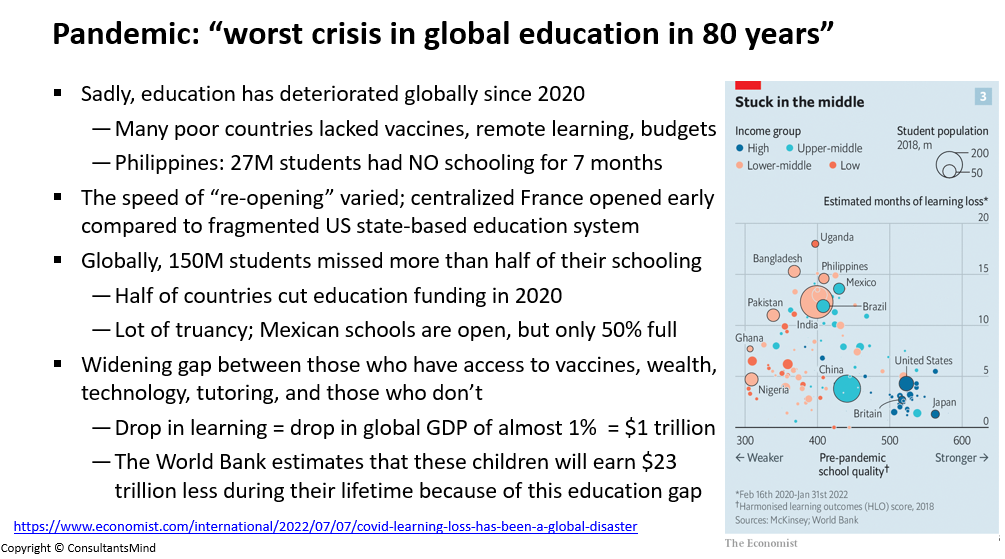Parents worry about their kids’ education
Of course they do. That’s part of the job description. Clothe them, feed them, love them, teach them values, and give them the education they need to win in life. Yeah, talk about an underpaid job.
The last two years (2020-2022) has been a struggle
This is an understatement. I know some parents were juggling work, homeschooling, and sketchy WiFi internet access. Yet, I am also aware that many people in the world don’t have laptops, access to tutors, extra rooms for their kids to study, air-conditioning, and let’s not forget – effective vaccinations.
So, while I intuitively understand the “education gap”, I didn’t understand the magnitude until I read this Economist article entitled, Covid learning loss has been a global disaster, Economist, July 7, 2022.
The Economist article is 2,700 words and very readable. McKinsey has a 22 pg report on the same topic here.
Practice making 1 page powerpoint
I created a 1 page PowerPoint which captures – what I believe to be – the most important parts of the story. After you read the Economist article, I’d be curious what your slide looks like. Note, this slide took me a bit more time, maybe 2 hours, because the original article was a bit “rambly”. They gave lots of great examples, but it took some time to re-arrange it in my mind. Also, I created 2-3 different slides, destroyed them, and started over.

Write a clear title
It’s never a bad idea (yes, double negative) to write a clear title that says something. In this case, it’s a quote towards the end of the article that calls the global education stop / pause / tentative restart a “crisis” and a “disaster”. The subtext of the Economist title is “wasted minds.” Okay, Economist, got the point.
1 Pagers = like an executive summary
I teach junior consultants to always (yes that’s a severe word) to have an executive summary in their longer presentations. Answer first. A 1 pager is essentially an executive summary. You have to be comprehensive, fit the words and graphics in, and be succinct. . . and say something.
Say what you want to say
The first word on the first bullet is “sadly” because DAMN, this is sad. You might not be allowed this level of intimacy or directness on your client deliverables, but definitely insert your voice, point-of-view and humanity when it’s appropriate. I like to write like I speak. NB: This is just my advice, so if your managing director wants you to write more formally, please defer to her. Create presentations for other people.
Lack of vaccines
Oddly, the article did not mention the word “vaccines”. So, while the Economist did not directly point out the lack of vaccines as an obstacle for the lower-income countries opening up the schools, I added it to the first bullet.
In the US and other OECD countries, we were able to get to the front of the (metaphorical global) line for vaccines. Many people in the world still don’t have adequate vaccinations. The Economist notes in a different article that only half of the Chinese over 80 years-old do not yet have double vaccinations.
Situation varies a lot by country
One of the main points of the article is that there is a huge divide between the wealthy North (read: N America, Europe, Northeast Asia) and the lower-income South (read: Latin America, Africa, Southeast Asia).
I included the chart on the right (which is a bit of an eye-chart), but shows that India has a HUGE (both in population, and also in the # of months of delayed educational development per student) education deficit.
Also, you will see that I also mention multiple countries: US, France, Mexico, Philippines.
Use data to prove your arguments
Data keeps consultants safe. It helps them to argue their points with more credibility:
- If 50% of countries cut their education budget (and didn’t restore the money back) = trouble
- If schools in Mexico are open, and yet attendance is 50% = trouble
What’s next?
This article was eye-opening. The harm to those young kids – not learning – and goofing off at home, watching TV, and falling off the schooling track is potentially devastating. The article mentions a few interventions – revised curriculums, tutoring, and better assessments – but they sounded more like salve than a solution. Not sure the McKinsey report was any better. They talk about resilience, re-enrollment, recovery, and reimaging the education system. Catchy that it has 4 “R”, but so far, it’ been a lot of discussion of the problem.
For me, we’re at a crossroad. Time to re-think how primary and secondary education can be democratized and decentralized. Of course, this takes money, willpower, and a strategy. But there are best practices for teaching online. There is an opportunity to enlist, train, and launch a new generation of teachers to meet students “where they are”. . . which frankly, is online.
As a separate encouraging note, Khan Academy is launching a One World Classroom – open enrollment for anyone in the world, next month August 2022 here. Let’s wish them luck.
